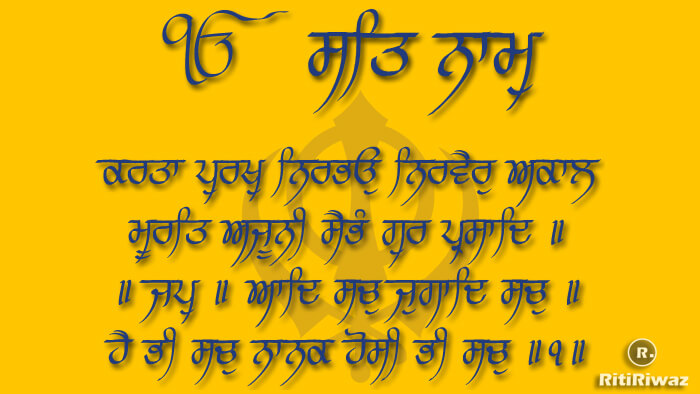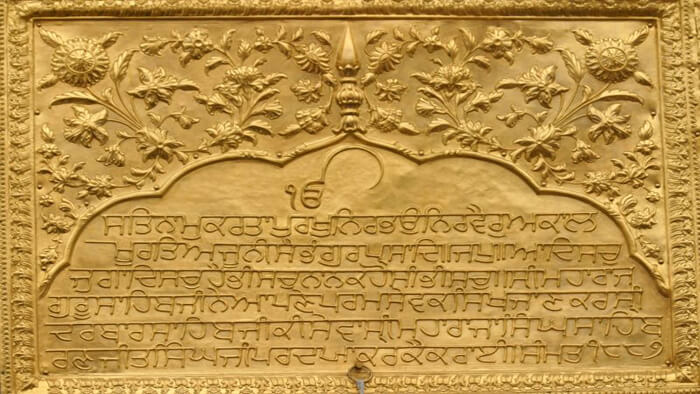The Sikh Mool Mantra – Ik Onkar

The core belief of Sikhism is given on the top of the first page of the Guru Granth Sahib, the Sikh Scriptures, in what is called the Mool Mantra. The Sikh Mool Mantra is the most important composition contained within the Sri Guru Granth Sahib. The opening verse followed by Bani (prayer) of ‘Jap Ji Sahib’ was composed by Guru Nanak Dev.
It is a ‘mantra’ in the sense that its message is to be taken to heart and to be worked into our lives. It defines the very foundations of the Sikh faith and, as such, is repeated frequently in the Guru Granth Sahib. The latter represents the most succinct description of Sikh belief, ‘Ek Onkar – Sat – Gurparsad ’, and is the closest thing to Sikhism in a nutshell.
The Adi Granth begins with the following hymn composed by Guru Nanak and known as “Mool Mantar” or the Morning Prayer in Sikhism:
ੴ ਸਤਿ ਨਾਮੁ ਕਰਤਾ ਪੁਰਖੁ ਨਿਰਭਉ ਨਿਰਵੈਰੁ ਅਕਾਲ ਮੂਰਤਿ ਅਜੂਨੀ ਸੈਭੰ ਗੁਰ ਪ੍ਰਸਾਦਿ ॥
इक्क ओन्कार सत नाम करता पुरख निरभऊ निरवैर अकाल मूरत अजूनी सैभं गुर प्रसाद ॥
Ikoaʼnkaar saṯ naam karṯaa purakẖ nirbẖau nirvair akaal mooraṯ ajoonee saibẖun gur parsaaḏ.
Meaning
“There is One Universal Creator, Sustainer & Destroyer; The Name is Truth; the Doer pervading in everything; Without Fear; Without Hate; Timeless Undying Image; Beyond Birth; Self-existing; Known through the True Guru’s Grace.”
There is One God (ੴl EkOnakar); Truth is its name (ਸਤਿਨਾਮ l Satnam).
He is the Creator (ਕਰਤਾ ਪੁਰਖੁ l Karta Purakh); Is without Fear (ਨਿਰਭਉ l Nirbhao).
Is without Hate (ਨਿਰਵੈਰ l Nirvair); An Eternal, Indestructible Entity (ਅਕਾਲ ਮੂਰਤਿ l Akaal Moorat).
He is beyond birth & death (ਅਜੂਨੀ l Ajoonee); He is self-existent (ਸੈਭੰ l Saibhan).
He is realized by His grace (ਗੁਰ ਪ੍ਰਸਾਦਿ l Gur Prasaad).
Worship by reciting (ਜਪੁ l Jap)
In the beginning there was Truth (ਆਦਿ ਸਚੁ I Aad such).
As time & ages went by, He was the Truth (ਜੁਗਾਦਿ ਸਚੁ l Jugaad such).
Even now, He is the Truth (ਹੈ ਭੀ ਸਚੁ l Haibee such).
Says Nanak: Truth shall prevail forever (ਨਾਨਕ ਹੋਸੀ ਭੀ ਸਚੁ l Nanak Hosee bhee such).
It sums up the Sikh belief of One God, the remaining Sri Guru Granth Sahib Ji is an elaboration of this Mool Mantra which is the main message. Mool Mantar has at least twelve known abbreviated modifications, appear interspersed as headings, to various sections of the Gurbani all throughout scriptures such as “Ik Onkar Sat Gur Prasad”.
It can be recited by the followers of Sikhism as a part of their morning and evening worship at any time of the day. It can also be recited while using a prayer bead Mala so you can keep count of the number of times that you have recited it, for a specific time period or as the spirit moves the one who recites the Mool Mantar. You can also recite it silently while working or audibly during your bibek langar, Karah Prasad, or Naam Ladoo preparation.
Mool Mantar is also recited by the Amrit administrators during the final phase of the initiation ceremony and is being repeated by the initiates. Instructions of reciting Mool Mantra every day throughout their lives are being given also to initiates in order for them to become enlightened by the Gurbani. It is considered to be the most important verse of all Gurbani Scripture and the underlying foundation of all the teachings of Sikh.
Why do some Sikhs read Mool Mantar up to ‘Nanak Hosee Bhee Sach’?
Some Sikh schools and groups believe Mool Mantar does not end at “Gur Prasaad” but “Nanak Hosee Bhee Sach.” If you see the first page of Sri Guru Granth Sahib Ji, after Gurprasad there are only two dandees, whereas at the end of “Nanak hosee bhee sach” there are not only two dandees but four dandees with the number 1 in between (i.e. ||1||). Sri Guru Nanak finishes the Mool Mantar here after putting the figure One. The whole Sikh scripture is one. The whole scripture describes the true form of God. This is interpreted to mean that Mool Mantar ends at the four dandees, i.e. after “Nanak hosee bhee sach”.

At one of the entrances of Harmandir Sahib (the Golden Temple), “Ek Oankaar” to “Nanak Hosee Bhee Sach” is engraved in gold at the top of the door. This was engraved by the carpenter of Maharaja Ranjit Singh in the 19th century. (Note: “Ek Oankaar” to “Gur Prasaad” is engraved in another entrance of Harimandir Sahib).
Whether you believe the Mool Mantar ends in ‘Gurprasad’ or in the other believing in ‘Hosi be Sach’, all we can say is we believe for it to end on ‘Hosi Be Sach’ though we recognize many now believe it should end on ‘Gurprasad’ it’s all up to one own belief.






